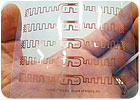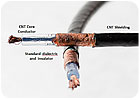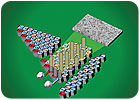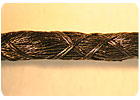
Automotive, aerospace and military manufacturers have relied on wiring harnesses for decades. But, as products grow more complex and weight reduction becomes more critical, engineers are eager to find an alternative. Evolving technology, such as carbon nanotubes, fiber optics and printed electrical systems, may provide the backbone of future electrical distribution systems in cars, trucks, locomotives, aircraft and other vehicles.
Despite recent price hikes, traditional copper wire bundles will probably continue to be used for years to come, due to outstanding electrical performance and ease of use. Copper wire is a safe, proven commodity that engineers are comfortable with. In addition, manufacturers already have large amounts of money invested in wire processing equipment, such as strippers, cutters, crimpers and welders.
“Wire is still the best way to go for many applications,” says Chris Burns, director of electrical-electronic architecture engineering at Delphi Corp. “It has the best conductivity you can get. That’s why we’ll still have a need for traditional systems for a long time to come.”
But, there’s a limit on how far wire can go. For instance, Delphi engineers are using more 26 AWG wire to reduce weight and space in some automotive applications. And, some medical device manufacturers currently use wire as small as 40 AWG, which boasts a 0.08 millimeter diameter. While pushing the boundaries of thin-gauge wire is possible, there’s little room for error as it becomes exceedingly difficult to route tiny wires and cables in an efficient package.
Weight reduction is also a growing challenge to many manufacturers, especially in the aerospace industry. For instance, the Boeing 747 contains more than 135 miles and 4,000 pounds of wire. Engineers are scrambling to reduce the size and weight of wiring harnesses as they develop more fuel-efficient aircraft.

Nanotech Takes Off
The aerospace industry is leading the charge to develop alternatives to traditional wire and cable. One technology that has tremendous long-term potential is nanotechnology. Carbon nanotubes (CNTs) are already being used for some military applications that require smaller and lighter wiring harnesses, such as unmanned aerial vehicles and satellites.Carbon nanotubes have a strength-to-weight ratio that is not matched by any other known material. Engineers at Nanocomp Technologies Inc. have figured out how to turn them into wiring that has very high tensile strength, highly efficient electrical conductivity, electromagnetic interference (EMI) shielding capabilities and extreme light weight.
During the past few years, Nanocomp has been involved in several research projects with the U.S. Air Force and Northrop Grumman Aerospace Systems. “The nature and importance of these projects demonstrates the unique potential of our material as the basis for creating game-changing, yet cost-effective replacements for traditional aerospace components,” says Peter Antoinette, president and CEO of Nanocomp. “We’ve proven that the performance of CNT wiring is superior to that of copper for high-frequency applications, with dramatic weight savings.”
There are several benefits to using CNT-based wiring as an alternative to traditional solutions, including:
Weight savings. “By using [our] CNT tape product as a replacement for conventional copper and aluminum cable shielding, aerospace manufacturers can achieve additional savings of up to 50 percent, while maintaining comparable or better electrical performance,” claims John Dorr, vice president of business development at Nanocomp. “In the case of center conductors, [weight savings can be] as much as a 10 percent.”
Copper competitiveness. “[Our] CNT materials are significantly lighter than traditional copper wiring technology,” says Antoinette. “[The material weighs only] 0.4 grams per cubic centimeter, as compared to copper, which is nearly 9 grams per cubic centimeter. In addition, especially at higher frequencies, CNT wiring exhibits comparable or better conductivity than conventional copper.”
Reliability. “Flex testing has demonstrated [that] CNT conductors exceed flex limits of copper by several orders of magnitude, offering a more reliable solution for many wiring applications,” Dorr points out.
Temperature stability. “CNT wires typically demonstrate more stable resistivity characteristics as a function of temperature, which is not the case for copper, particularly as higher temperatures come to bear,” explains Dorr. CNT’s also do not corrode like conventional copper wires, which can alleviate early failures due to overheating.
Nanocomp engineers are currently working with Northrop Grumman to develop next-generation CNT cabling and tapes that are “intended for near-term insertion into aircraft as a replacement for conventional copper-based wires and cables.”
“The two-year program, entitled the Nanocomposite Connector Partnership, [aims] to define cable design parameters and replicable manufacturing processes,” says Don DiMarzio, integrated product team leader for emerging concepts at Northrop Grumman Aerospace Systems.
“The end result will be an optimized manufacturing platform designed to produce efficient and cost-effective materials, so that transition and broad-based implementation of carbon nanotube-based conductors can take place,” claims DiMarzio. “We believe this initiative will result in a true 21st century solution to vastly improve the weight and fuel efficiency of modern aircraft, for sustainable cost and energy savings.”
Carbon nanotube sheet and yarn materials are wound on spools like traditional wire. Nanocomp uses a combination of custom-built and off-the-shelf hardware, along with proprietary processes, to manufacture its CNT sheet and wire products.
“We envision widespread adoption [of the technology in the aerospace and military industry] in less than five years, likely sooner,” says Dorr. To anticipate growing demand, Nanocomp is in the process of moving into a new, large-scale manufacturing facility.
Despite numerous benefits, widescale use of nanowire will be hampered by capacity and cost challenges. “Wire solutions require relatively high levels of manufacturing capacity compared to other applications for CNTs,” notes Dorr. “In addition, most interconnect solutions are price-sensitive, as they are often more of a commodity than a specialty solution.
“A second challenge is implementing CNT wiring solutions for DC power applications,” adds Dorr. “Today, CNT wiring is better suited for RF-signal solutions. Copper continues to outperform CNTs at low frequencies.”
Automotive engineers also see tremendous potential for CNT wires. “It has some intriguing possibilities,” says Burns. “Delphi is expanding our R&D efforts on nanotechnology.”
The Honda Research Institute USA Inc. has been studying the topic for several years, working in conjunction with engineers at Purdue University and the University of Louisville. “Microscopic carbon nanotubes a hundred thousand times thinner than a human hair may have the potential to transport electricity faster and over greater distances with minimal loss of energy,” claims Hideaki Tsuru, project director.
“[Our] findings open new possibilities for miniaturization and energy efficiency, including . . . electrical cables,” adds Tsuru. At Honda’s lab, CNTs are grown on the surface of metal nanoparticles, taking the cylindrical form of rolled honeycomb sheets with carbon atoms in their tips.
“When these tiny carbon nanotubes exhibit metallic conductivity, they possess extraordinary strength compared to steel, higher electrical properties than copper, are as efficient in conducting heat as a diamond and are as light as cotton,” Tsuru points out. Honda has already achieved a success rate of 91 percent metallic conductivity.

Fun With Fiber
Fiber optic technology is not as sexy as carbon nanotubes, but it also has potential to replace traditional electrical wiring in some products, such as airplanes and helicopters. Light-transmitting cables weigh less and take up less space than copper wiring in aircraft. They also have better immunity from strong radio signals and lightning, are free from short circuit arcing and can carry more electronic signals.A fiber optic control system could result in lighter, more fuel-efficient airplanes with more reliable control and monitoring systems. According to engineers at NASA’s Glenn Research Center, weight and fuel savings in aircraft engineered with fiber optic control systems could be substantial, compared to designs using traditional copper wiring. Long copper cables not only weigh more than fiber optics, but also must be shielded with insulation to protect other aircraft systems from signal leaks.
“Fiber strands the size of a hair can convey hundreds of high-speed signals, replacing bulky and heavy copper cables,” says Ronald Bishop, president of Bishop & Associates Inc., a market research firm that recently published a new report on fiber optic connectors in military and commercial applications. “The ability to transmit signals many kilometers without amplification was immediately adopted by the telecom industry in long-haul applications, but wide market adoption in additional market segments has stumbled due primarily to cost.”
The idea of using fiber optics for aerospace applications is not new-NASA engineers studied the concept in the late 1980s and early 1990s. They discovered that digital signals would travel more quickly between locations in an aircraft equipped with fiber optic controls because fiber optic cables do not have the built-in resistance that copper cables have to electricity running through them.
But, fiber optics failed to catch on for many non-telecom applications. “The immanent demise of copper has been predicted many times over the years, but a combination of advanced chip technology together with improvements in design for signal integrity has allowed engineers to find ways to expand the practical bandwidth of copper,” Bishop points out. “Costs associated with the required electro-optic conversion process, together with connectors that require skilled technicians to successfully terminate, discouraged broad market conversion to fiber.
“As we reach system requirements for [unlimited high-speed bandwidth and multiple] channels, fiber is again gaining attention as a viable alternative,” claims Bishop. “Fiber optic links are beginning to approach cost parity with copper in many applications.”

Printable Wiring
In the near future, wiring harnesses, connectors and other electrical components may be printed with the touch of a button. Printed electrical systems are an offshoot of printed electronics, a fast-growing field.
Printed electronics are based on flexible substrates of functionalized polymer films that are less than 1 millimeter thick. “The market potential for printed electronics is huge,” claims Wolfgang Mildner, chairman of the Organic and Printed Electronics Association (OE-A). “Thinness, flexibility, robustness and easy integration are the competitive advantages of this new technology.”
Klaus Hecker, OE-A’s managing director, believes there could be numerous applications for the technology in the auto industry. “By mid decade, there will be fully integrated, smooth and aesthetically pleasing interiors with embedded displays and switches,” he predicts. “They will show only when needed and be activated by slight touch.
“This will also pertain to the exterior: very thin, yet brilliant organic LED backlights [will be] directly glued to the car body,” Hecker points out. “Printed conductors [will] connect with the car’s electrics. [There will be] no screws, no parts protruding to the densely packed innards.”
“Completely printed and laminated replacements for instrument clusters and wiring will save weight, cost and space in cars,” adds Peter Harrop, chairman of IDTechEx, a consulting firm specializing in printed electronics. “Wireless sensors and actuators will also save wiring in future vehicles and gradually be printed themselves.”
Conductive inks will allow manufacturers to print some electrical systems. “The technology has the potential to be applied to composite panels used in aircraft fuselages and automotive bodies,” says Stan Farnsworth, vice president of marketing at NovaCentrix, which has developed a copper ink called Metalon.
“True copper inks are available for screen, flexographic or gravure application,” adds Farnsworth. “In conjunction with our PulseForge technology, these inks can be applied to substrates such as plastic films and even paper.”
The PulseForge tools use brief, extremely high-powered pulses of light from custom lamps to sinter inorganic inks and films at room temperature. The combination of Metalon and PulseForge allows conductivity requirements to be met using thin, flexible substrates. Most substrates remain unaffected because of the very short pulse duration.
“There’s been a lot of interest in this process,” says Farnsworth, a mechanical engineer. “Most of the focus has been in the packaging industry, but it also has a lot of potential to replace traditional wiring in many industries. We’re currently working with some aerospace and military manufacturers.
“Printing is an additive process,” Farnsworth points out. “You put it where you want it. You’re not adding a wire after the fact. It allows you to get away from traditional wiring harness restrictions, such as size and weight. Printable electrical systems can also eliminate several design and assembly steps, which reduces cost and complexity. And, we use water-based inks to achieve a green manufacturing process.”
However, Farnsworth says copper ink technology still needs more development. For instance, “we’re currently at about half the conductivity of wire,” he explains. “We’re addressing issues relating to moisture, temperature and humidity.” A
Learn more about the future of wire by clicking www.assemblymag.com and searching for these articles:
- A World Without Wire?
- Wireless Technology May Let Robots Go Free
